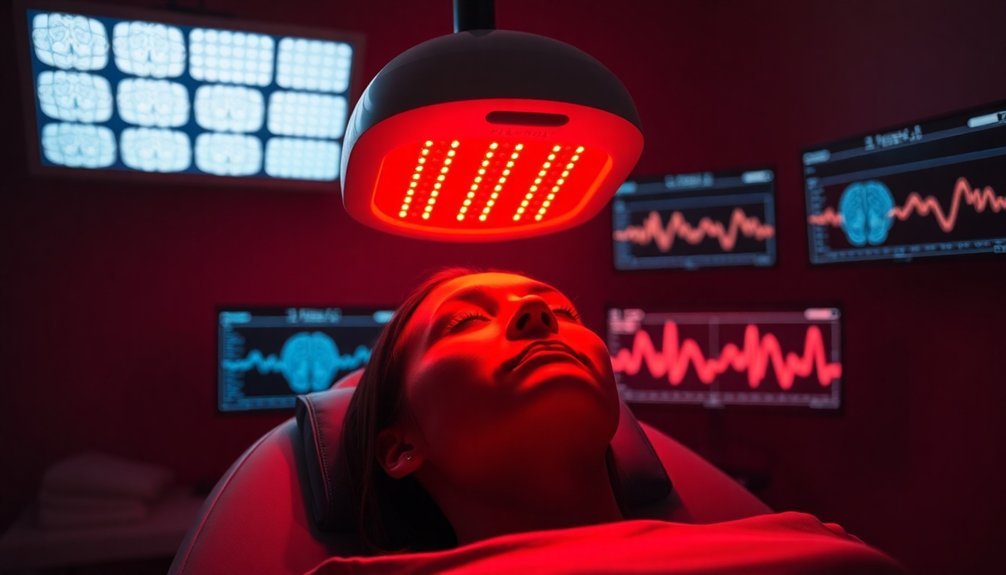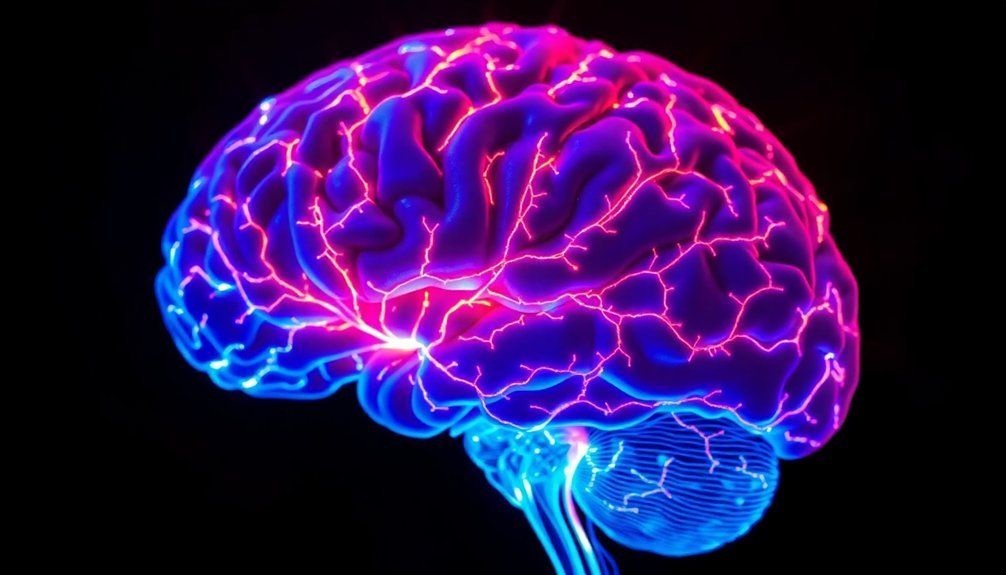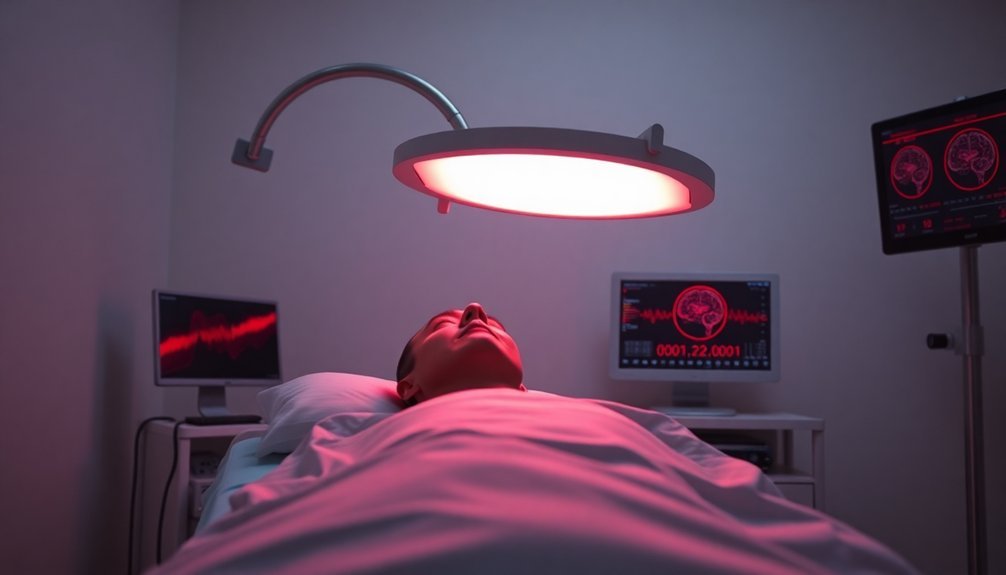Near-infrared light therapy can boost your brain's healing and function through targeted wavelengths that penetrate your skull and reach deep brain tissue. When the light hits your brain cells, it stimulates mitochondria to produce more ATP energy and increases blood flow through nitric oxide release. You'll find strong scientific evidence showing improvements in cognitive function, especially after traumatic brain injury, with studies revealing enhanced brain connectivity and reduced inflammation. This non-invasive treatment shows promise for conditions like TBI, Alzheimer's, and depression, with daily sessions lasting just minutes. The fascinating science behind this breakthrough therapy opens up new possibilities for neurological healing.
Understanding Near-Infrared Light Therapy

Near-infrared light therapy consistently demonstrates promising results in brain treatment through its unique ability to penetrate the skull and affect brain tissue. When you're exposed to near-infrared light, particularly at wavelengths around 808 nm, the light travels deep into your brain tissue through what scientists call the "optical window," allowing for effective treatment of underlying tissues.
The therapy works primarily by stimulating your cells' mitochondria, which act as cellular powerhouses. This stimulation boosts your body's production of ATP (adenosine triphosphate), improves blood flow, and reduces inflammation without causing thermal damage to your tissue. Studies have shown that this process actively promotes neurogenesis and synaptogenesis, creating new neural pathways and connections.
Research has shown that specific light doses between 0.9 and 15 joules per square centimeter effectively trigger these beneficial cellular responses.
You'll find this treatment particularly effective for damaged brain cells, as it targets compromised tissue and promotes recovery. The therapy's non-invasive nature and lack of thermal effects make it an attractive option for various neurological conditions.
Scientists have confirmed that the mechanism is primarily photochemical rather than heat-based, which means you're getting the benefits of cellular repair without the risks associated with tissue heating.
Brain Recovery After Head Trauma
Three distinct phases characterize your brain's recovery after head trauma, beginning with the critical initial stage where swelling and altered brain chemistry affect healthy tissue function.
During early recovery, you'll notice improvements as swelling decreases, with restored sleep-wake cycles and better responses to commands. The progression phase then follows, where cognitive and motor abilities continue to improve at varying rates. Studies show that most brain injury recovery occurs within the first two years post-injury.
Your recovery timeline depends heavily on the severity of your injury. While mild TBIs often resolve within three months, moderate and severe cases require longer healing periods. You'll experience the most rapid improvements during the first six months, though recovery can continue for years.
Key factors that influence your recovery journey include:
- The severity and location of your brain injury
- The duration of unconsciousness following trauma
- Your age, with older patients typically requiring more recovery time
- The types of therapeutic interventions you receive
Early intervention and consistent therapeutic support substantially impact your outcomes. You can enhance your recovery by maintaining healthy behaviors, avoiding alcohol and drugs, and following your healthcare team's recommendations for rehabilitation services.
Cell-Level Healing Mechanisms

A remarkable cascade of cellular healing begins when infrared light penetrates your brain tissue. When near-infrared light reaches your cells, it's absorbed by cytochrome C oxidase in your mitochondria, triggering increased ATP production and powering your cells' repair mechanisms.
You'll experience multiple levels of cellular regeneration as the therapy activates key healing processes. The light stimulates the release of nitric oxide, improving your blood circulation and cellular communication. The optimal wavelength of 810 nanometers penetrates deepest into brain tissue, maximizing therapeutic benefits.
It also promotes the production of growth factors like BDNF, which drives neuronal repair and the formation of new brain cells.
Your brain's protective mechanisms kick into high gear as the infrared light reduces inflammation by calming overactive astrocytes and microglial cells. You'll benefit from enhanced neuroplasticity through increased synapse formation and dendritic branching, while the therapy simultaneously protects your neurons from oxidative stress.
At the molecular level, the light therapy triggers the formation of new blood vessels by upregulating HIF1α and VEGF, ensuring better oxygen delivery to your brain tissue. This coordinated healing response helps your brain cells proliferate and repair themselves while maintaining ideal cellular function through improved energy production.
Clinical Research and Treatment Results
Building on these cellular mechanisms, extensive clinical research has validated the effectiveness of infrared brain therapy for treating traumatic brain injuries. Studies involving both preclinical models and human participants consistently demonstrate significant improvements in recovery outcomes, particularly when using 810nm wavelength light.
You'll find the most compelling evidence in clinical studies that track patient progress through functional MRI and performance tests. Research shows that daily two-minute infrared light treatments in the first three days post-injury can lead to remarkable improvements. Near-infrared light therapy has proven to be both safe and noninvasive for patients.
Here are the key documented benefits:
- Enhanced brain connectivity within the first two weeks of recovery, especially in regions affected by trauma
- Significant improvements in balance and cognitive function by the four-week mark
- Reduced inflammation through decreased activation of astrocytes and microglial cells
- Measurable reduction in cell death markers
These research-backed results have sparked interest in developing medical devices for widespread clinical use. While larger studies with longer follow-up periods are still needed, the current evidence strongly supports infrared therapy's potential for treating traumatic brain injuries and related neurological conditions.
Future Applications in Brain Health

Breakthrough research in infrared brain therapy points to promising applications beyond traumatic injuries. Most significantly, it's showing remarkable potential in treating neurodegenerative conditions like Alzheimer's and Parkinson's disease.
You'll find that near-infrared light therapy may help reduce amyloid beta proteins and delay neurodegeneration in Alzheimer's patients, while also improving motor skills in those with Parkinson's.
The therapy's future looks particularly bright for mental health conditions. If you're dealing with PTSD, depression, or anxiety, you might benefit from this treatment as it increases mitochondrial energy production in brain cells. It's also showing promise for long-haul COVID cognitive symptoms and various forms of dementia.
Scientists are working to optimize delivery methods through specialized helmets and nasal devices, using wavelengths between 633-1065 nm for maximum brain penetration. While current results are encouraging, you should know that researchers are pushing for more large-scale clinical trials and standardized protocols.
They're also exploring innovative approaches, including combination therapies with cognitive rehabilitation and the development of more targeted devices to enhance treatment outcomes.
Frequently Asked Questions
How Much Does Near-Infrared Light Therapy Typically Cost per Session?
You'll typically pay $25-$200 per session for near-infrared light therapy, depending on the treatment area. Small handheld device sessions cost $25-$100, while full-body treatments using light panels range from $50-$200.
Can Near-Infrared Light Therapy Be Safely Combined With Traditional Medications?
You'll need to consult your doctor before combining near-infrared light therapy with medications, as there's limited research on potential interactions. Always disclose all treatments you're using to your healthcare provider for safety.
Are There Any Age Restrictions for Receiving Near-Infrared Light Therapy?
While there aren't specific age restrictions for near-infrared light therapy, you'll need to consult your healthcare provider first, especially for children, elderly individuals, or if you have underlying health conditions or take medications.
How Soon After a Brain Injury Should Someone Start This Therapy?
You'll want to start near-infrared light therapy within 72 hours of your brain injury for the best results. Early intervention can reduce inflammation and protect against secondary damage, improving your chances of better recovery outcomes.
What Are the Potential Side Effects of Long-Term Near-Infrared Light Use?
You might experience skin sensitivity, headaches, and eye strain with long-term near-infrared light use. There's also a risk of burns if you don't follow safety guidelines, and potential neurological overstimulation effects.
In Summary
You'll find near-infrared light therapy offers promising advances in brain recovery and neurological healing. Research shows it's particularly effective for treating head trauma and promoting cellular repair at the deepest levels. While more studies are needed, you can expect to see this non-invasive treatment expand into various brain health applications. It's an exciting development that's transforming how we approach neurological care and rehabilitation.





Leave a Reply